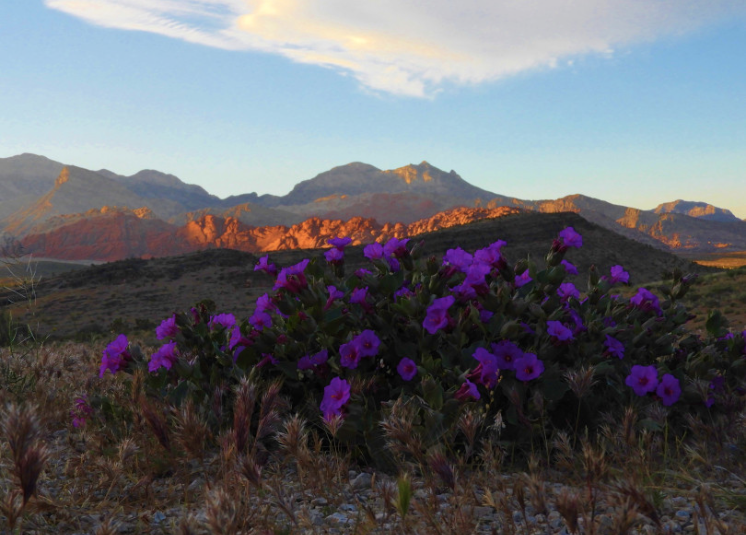
Hiking in Las Vegas? These travelers bet on it
Behind a foreground of springtime blossoms, sunset-lit Red Rock Canyon glows and beckons hikers. (Karen Hansen Gurstelle)
On the north side of Las Vegas, an almost forgotten path winds up a steep, rocky hill. From the top, views of the runways of sprawling Nellis Air Force Base stretch to the northeast. Off to the west, there’s a view of the Las Vegas skyline and beyond to Charleston Peak. And just below, at the hill’s eastern base, is a cleft in the rock that is a rare scientific wonder known as the Great Unconformity.
The Great Unconformity is a geological rift in time and space of earth-shattering magnitude. Precambrian granite from 1.7 billion years ago juts out of the earth next to Jurassic sandstone from 500 million years ago. As unexpected as a photo of Aristotle driving a Tesla, the Great Unconformity is one of science’s most surprising propinquities, created when subterranean forces pushed rock layers past one another at a fault line, bringing together strata that have no business being near one another.
The Great Unconformity is an apt analogy for Las Vegas, where everywhere opposites abut: poverty and prosperity, water and wasteland, hubris and humility, nature and neon.
During our visit in May, we spent daytimes immersed in grand nature, clambering, hiking and driving. We spent the nights amidst glittering neon, reveling in the Old Vegas nostalgia and New Vegas haute cuisine and mixology.
RED ROCK CANYON
After reaching the summit of the Calico Tanks Trail in Red Rock Canyon, hikers perch on the mountainside and enjoy the panorama of colorful terrain and sunlight reflected from the Luxor hotel. (Karen Hansen Gurstelle)
Spring daytimes in the desert are ideal for hiking along the diverse, dramatic trails available just outside the city. Ask Vegas residents about their favorite natural spot and odds are they’ll name Red Rock Canyon. A huge National Conservation Area less than an hour’s drive from the Strip, Red Rock Canyon is well interpreted and contains some of the best day hiking in the nation with so many trails it was hard to choose just one.
Luckily, we found Chandra Teeter, an experienced hike leader and park volunteer, in the visitors’ center. When we told her we had three to four hours to spend, Chandra didn’t hesitate. “Either Ice Box Canyon or the Calico Tanks would be great for you,” she said. “But Calico Tank trail will take you right up into the red rock that is the essence of this park.”
And what a hike it was. The out-and-back trail climbs 450 feet from the desert up through a colorful jumble of rock strata. Along the way, we encountered history, geology and diverse groups of international and local trekkers. The trail guide lists this trail as “moderate” in difficulty but make no mistake, this is no walk in the park and having a hiking pole is a smart move. The trail is steep in parts and sometimes disappears, requiring finding your own way across expanses of horizontal rock and some hand and footwork and a bit of butt sliding through the more vertical sections. Of course, that is precisely what makes this trail so much fun. That and the spectacular visual rewards: the surprisingly colorful mix of vegetation and rock along the way, then the mountain pond called Calico Tank near the top and finally, at the top, a sweeping view of the Las Vegas Strip far below in the distance.
RAILROAD TUNNEL TRAIL
Hoover Dam (Karen Hansen Gurstelle)
Compared to Red Rock trails, our nine-mile round-trip trek from Lake Mead through the high Mojave Desert to the Hoover Dam was more like a long walk in a very sunny, exposed park. What little shade there is along the way is the chief attraction of this path: the railroad tunnels.
The Railroad Tunnel Trail, starting at the visitor center for Lake Mead, takes hikers through five old railroad tunnels all the way to Hoover Dam. Long and cool and now home to screech-y bats, the tunnels were constructed in the 1930s to accommodate the delivery of materials for the dam builders. During the dam’s construction, a constant stream of gas and steam locomotives connected the project’s quarries, gravel pits and cement-mixing plants. Remote and with few users, the trail is well marked with interpretive signs explaining the historical and scientific significance of the area. It was fascinating to imagine the bustle and noise of that go-go infrastructure-building era as we took in the drama of human-made Lake Mead, Hoover Dam and the Pat Tillman Bridge, which is the widest and highest span of concrete in the Western Hemisphere.
READ FULL ARTICLE: http://www.twincities.com/2017/09/03/las-vegas-hiking-casinos/
